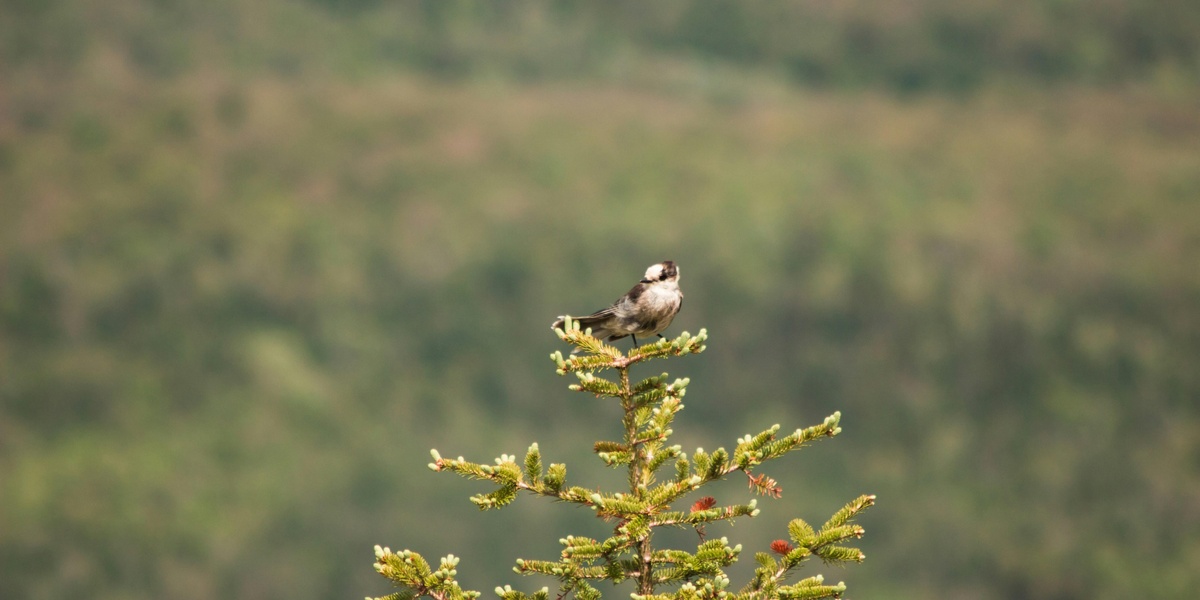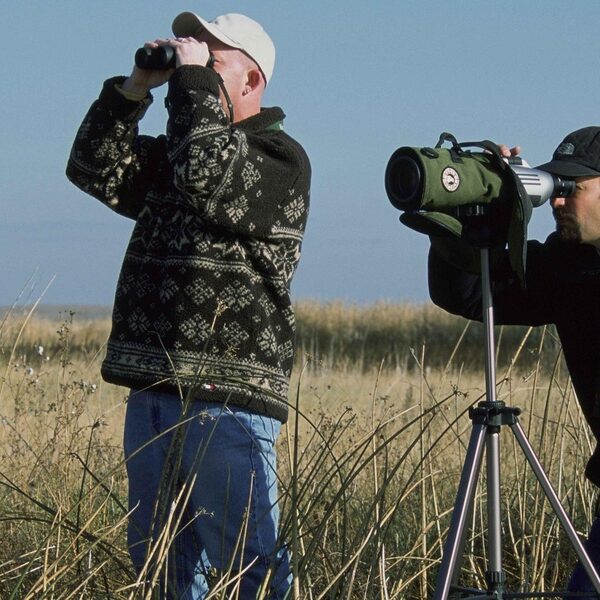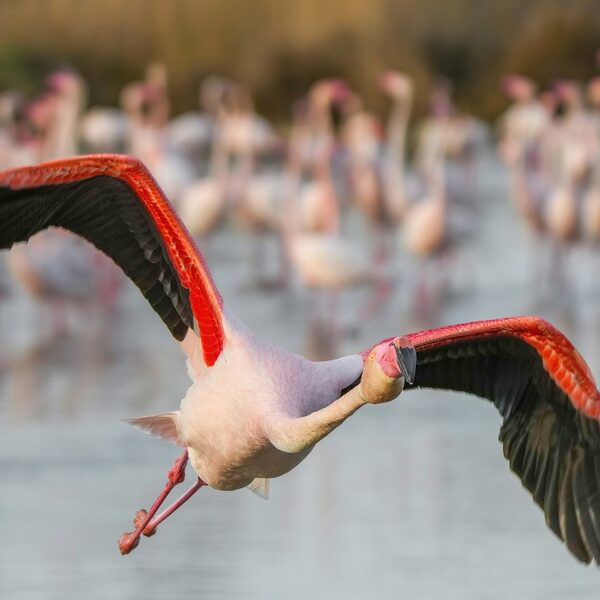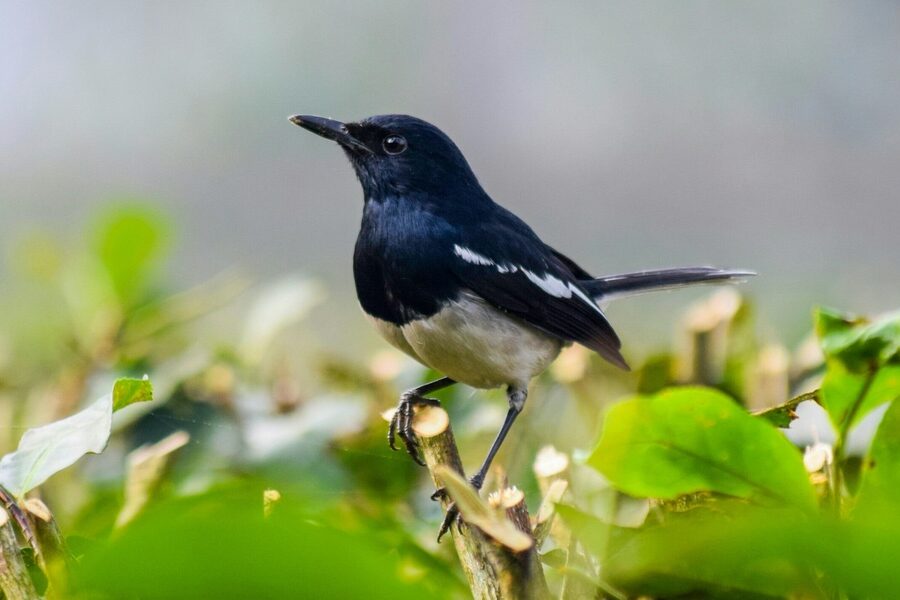Stretching across the northern hemisphere, the boreal zone supports a distinctive mix of songbirds, flycatchers, warblers and boreal specialists tied to spruce, fir and birch habitats. This list gathers those species into a single reference for birders and naturalists working in northern forests.
There are 68 boreal forest birds, ranging from Alder Flycatcher to Yellow-rumped (Myrtle) Warbler. For each species the table lists Scientific name,Size (cm) & status,Range & season — details you’ll find below.
When is the best time to see species on this list?
Spring migration into early summer (May–July in many areas) is typically the easiest time to observe and identify most species because migrants are vocal and breeding; a few species are more visible in late summer during post-breeding dispersal, and winter sightings are limited to residents and irruptive visitors—check the Range & season column for specifics.
How should I use the Scientific name,Size (cm) & status,Range & season columns?
Use the scientific name to avoid confusion between similar common names, Size (cm) & status to gauge how likely you are to encounter a species and aid field ID, and Range & season to plan when and where to look; combine this with local checklists or eBird for up-to-date occurrence data.
Boreal Forest Birds
| Common name | Scientific name | Size (cm) & status | Range & season |
|---|---|---|---|
| Spruce Grouse | Falcipennis canadensis | 35 cm & Least Concern | Boreal North America; year-round resident |
| Ruffed Grouse | Bonasa umbellus | 48 cm & Least Concern | North American boreal and mixed woods; year-round resident |
| Capercaillie | Tetrao urogallus | 74 cm & Least Concern | Eurasian boreal conifer forests; year-round resident |
| Hazel Grouse | Tetrastes bonasia | 35 cm & Least Concern | Eurasian taiga; resident and secretive |
| Willow Ptarmigan | Lagopus lagopus | 35 cm & Least Concern | Holarctic boreal and tundra; year-round resident |
| Black-backed Woodpecker | Dryobates arcticus | 27 cm & Least Concern | Boreal North America; breeds in burned and mature conifers |
| American Three-toed Woodpecker | Picoides dorsalis | 21 cm & Least Concern | Boreal North America; resident in conifer forests |
| Three-toed Woodpecker | Picoides tridactylus | 22 cm & Least Concern | Eurasian boreal forests; resident |
| Black Woodpecker | Dryocopus martius | 48 cm & Least Concern | Eurasian taiga; resident |
| White-backed Woodpecker | Dendrocopos leucotos | 23 cm & Least Concern | Eurasian boreal and mature forests; resident |
| Great Gray Owl | Strix nebulosa | 61 cm & Least Concern | Boreal Holarctic; resident and irruptive |
| Boreal (Tengmalm’s) Owl | Aegolius funereus | 22 cm & Least Concern | Holarctic boreal forests; nocturnal breeder |
| Northern Hawk-Owl | Surnia ulula | 36 cm & Least Concern | Boreal Holarctic; resident and irruptive |
| Northern Saw-whet Owl | Aegolius acadicus | 19 cm & Least Concern | Boreal North America; summer breeder and nocturnal migrant |
| Eurasian Pygmy Owl | Glaucidium passerinum | 17 cm & Least Concern | Eurasian taiga; resident and daytime hunter |
| Northern Goshawk | Accipiter gentilis | 55 cm & Least Concern | Boreal Holarctic; breeding resident |
| Osprey | Pandion haliaetus | 60 cm & Least Concern | Boreal lakes and rivers; summer breeder, migratory |
| Merlin | Falco columbarius | 27 cm & Least Concern | Boreal Holarctic; breeds in open forest and bogs |
| Bald Eagle | Haliaeetus leucocephalus | 70 cm & Least Concern | Boreal coasts and large lakes; year-round/resident |
| Olive-sided Flycatcher | Contopus cooperi | 20 cm & Near Threatened | Boreal openings and edges; summer breeder, migratory |
| Yellow-bellied Flycatcher | Empidonax flaviventris | 12 cm & Least Concern | Boreal North America; breeds in mossy bogs and swamps |
| Alder Flycatcher | Empidonax alnorum | 13 cm & Least Concern | Breeds in boreal shrubby bogs; summer migrant |
| Gray-cheeked Thrush | Catharus minimus | 18 cm & Least Concern | Breeds in North American boreal forest; migratory |
| Swainson’s Thrush | Catharus ustulatus | 19 cm & Least Concern | Boreal and riparian forests; breeding migrant |
| Hermit Thrush | Catharus guttatus | 18 cm & Least Concern | Coniferous forests incl. boreal; breeding resident/migrant |
| Varied Thrush | Ixoreus naevius | 25 cm & Least Concern | West coast boreal forests; breeding and resident |
| American Robin | Turdus migratorius | 25 cm & Least Concern | Breeds widely including boreal clearings; summer migrant/resident |
| Redwing | Turdus iliacus | 23 cm & Least Concern | Eurasian boreal and taiga; breeding migrant |
| Common Raven | Corvus corax | 56 cm & Least Concern | Holarctic boreal; year-round resident |
| Gray Jay | Perisoreus canadensis | 26 cm & Near Threatened | Boreal North America; year-round resident |
| Siberian Jay | Perisoreus infaustus | 26 cm & Least Concern | Fennoscandian and Siberian taiga; resident |
| Eurasian Nutcracker | Nucifraga caryocatactes | 34 cm & Least Concern | Eurasian coniferous taiga; resident/irruptive |
| Boreal Chickadee | Poecile hudsonicus | 12 cm & Least Concern | Boreal Canada and Alaska; year-round resident |
| Siberian Tit | Poecile cinctus | 12 cm & Least Concern | Eurasian taiga; year-round resident |
| Willow Tit | Poecile montanus | 12 cm & Least Concern | Eurasian boreal; resident and cavity nester |
| Red-breasted Nuthatch | Sitta canadensis | 12 cm & Least Concern | Boreal North America; breeding and irruptive |
| Brown Creeper | Certhia americana | 13 cm & Least Concern | North American coniferous forests incl. boreal; breeding |
| Eurasian Treecreeper | Certhia familiaris | 13 cm & Least Concern | Eurasian taiga; resident and breeder |
| Blackpoll Warbler | Setophaga striata | 12 cm & Least Concern | Breeds in boreal conifers; migratory spring/fall |
| Bay-breasted Warbler | Setophaga castanea | 12 cm & Least Concern | Breeds in boreal forests; migratory |
| Blackburnian Warbler | Setophaga fusca | 12 cm & Least Concern | Breeds in boreal conifers; migratory |
| Yellow-rumped (Myrtle) Warbler | Setophaga coronata | 14 cm & Least Concern | Breeds in boreal conifers; breeding migrant |
| Tennessee Warbler | Leiothlypis peregrina | 11 cm & Least Concern | Breeds in boreal forests; migratory |
| Palm Warbler | Setophaga palmarum | 12 cm & Least Concern | Breeds in boreal bogs and low forest; migratory |
| Wilson’s Warbler | Cardellina pusilla | 11 cm & Least Concern | Breeds in boreal shrubby patches; migratory |
| Ovenbird | Seiurus aurocapilla | 17 cm & Least Concern | Breeds in boreal and mixed woods; migratory |
| Common Redpoll | Acanthis flammea | 13 cm & Least Concern | Birch and pine zones of boreal forests; winter and breeding |
| Pine Grosbeak | Pinicola enucleator | 26 cm & Least Concern | Boreal conifer forests; resident and irruptive |
| Evening Grosbeak | Coccothraustes vespertinus | 18 cm & Least Concern | Breeds in boreal and montane conifers; irruptive |
| Red Crossbill | Loxia curvirostra | 18 cm & Least Concern | Boreal conifer forests; resident and nomadic |
| White-winged Crossbill | Loxia leucoptera | 17 cm & Least Concern | Boreal conifer forests; irruptive and winter movements |
| Pine Siskin | Spinus pinus | 12 cm & Least Concern | Breeds in boreal conifers; irruptive migrant |
| Eurasian Siskin | Spinus spinus | 12 cm & Least Concern | Breeds in boreal and montane conifers; migrant |
| Eurasian Bullfinch | Pyrrhula pyrrhula | 17 cm & Least Concern | Eurasian taiga edges; breeding resident |
| White-throated Sparrow | Zonotrichia albicollis | 17 cm & Least Concern | Breeds in boreal scrub and forest edges; summer migrant |
| Dark-eyed Junco | Junco hyemalis | 15 cm & Least Concern | Breeds in boreal and montane forests; resident and migrant |
| Fox Sparrow | Passerella iliaca | 22 cm & Least Concern | Breeds in shrubby boreal thickets; summer migrant |
| Yellow-bellied Sapsucker | Sphyrapicus varius | 20 cm & Least Concern | Breeds in boreal mixed forests; migratory |
| Belted Kingfisher | Megaceryle alcyon | 31 cm & Least Concern | Boreal lakes and rivers; breeding migrant/resident |
| Bohemian Waxwing | Bombycilla garrulus | 19 cm & Least Concern | Boreal and taiga forests across Holarctic; irruptive |
| Steller’s Jay | Cyanocitta stelleri | 30 cm & Least Concern | Western coniferous forests incl. boreal mountains; resident |
| Eurasian Jay | Garrulus glandarius | 34 cm & Least Concern | Western Eurasian forests incl. taiga edges; resident |
| Common Goldeneye | Bucephala clangula | 44 cm & Least Concern | Breeds on boreal lakes; summer breeder, migratory |
| Barrow’s Goldeneye | Bucephala islandica | 48 cm & Least Concern | Breeds in boreal lakes and coastal pockets; migratory |
| Rusty Blackbird | Euphagus carolinus | 24 cm & Vulnerable | Breeds in boreal swamps and forested wetlands; migratory |
| Golden-crowned Kinglet | Regulus satrapa | 9 cm & Least Concern | Breeds in boreal conifers; migratory/resident |
| Ruby-crowned Kinglet | Regulus calendula | 9 cm & Least Concern | Breeds in boreal shrubby forests; migratory |
| Northern Shrike | Lanius borealis | 24 cm & Least Concern | Boreal North America; breeds and winters in open taiga |
Images and Descriptions

Spruce Grouse
Stocky, mottled conifer specialist often seen on forest floor or low branches. Males show darker plumage and red eye combs; freezes when alarmed. Found deep in spruce-fir stands, rarely far from dense conifers.

Ruffed Grouse
Cryptically patterned, medium-sized grouse that prefers young forests and dense understory. Males drum on logs in spring; often flush with a loud wing-beat. Common in boreal thickets and regenerating stands.
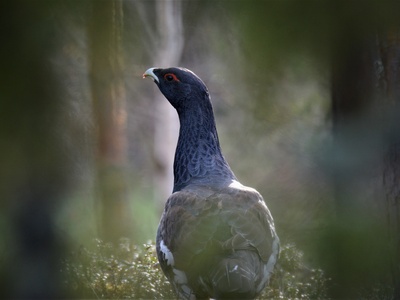
Capercaillie
Largest grouse of Eurasia, males are bulky with fan tails and deep calls. Prefers mature pine and spruce forests. Elusive outside lekking season; important indicator of intact old-growth taiga.
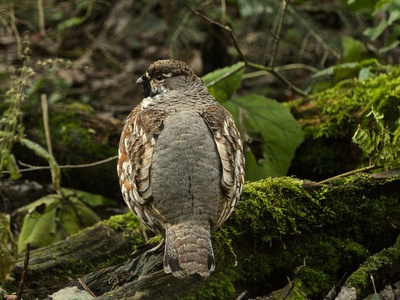
Hazel Grouse
Small, cryptic grouse of dense undergrowth with fine mottling and subtle facial patterns. Prefers mixed boreal woodland and bog edges; often heard more than seen, active at dawn and dusk.

Willow Ptarmigan
Stocky, ground-dwelling bird that changes plumage seasonally (white in winter, mottled in summer). Occupies shrubby bogs and forest edges in the taiga, feeding on buds and twigs.

Black-backed Woodpecker
All-black upperparts with white underparts; specialist of burned and beetle-infested stands. Often drums on charred trunks; a key species following wildfire outbreaks in boreal forests.

American Three-toed Woodpecker
Small, stout woodpecker with barred back and yellowish crown patch in males. Excels at excavating bark for wood-boring beetles; common in older boreal stands and recent burns.
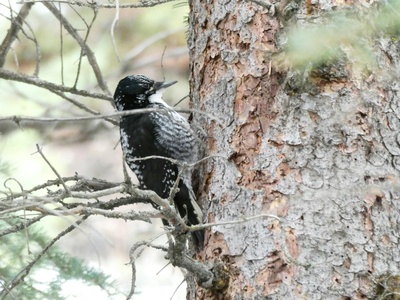
Three-toed Woodpecker
Black-and-white patterned woodpecker with a small bill and three toes. Forages on trunks for beetle larvae, often in burned or old-growth conifers. Quiet and hard to spot.
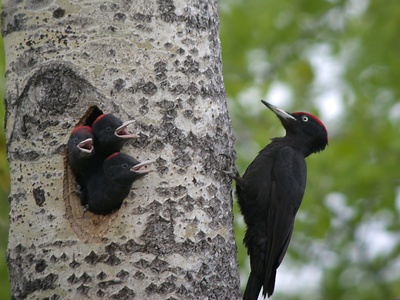
Black Woodpecker
Very large, crow-sized woodpecker all black with red crown (male). Excavates large cavities in mature boreal pines and spruces; voice is a loud, resonant “kweek.”

White-backed Woodpecker
Distinctive with a broad white back patch and strong bill. Favors old-growth deciduous and mixed stands with dead wood; specialist foraging on beetle larvae under bark.
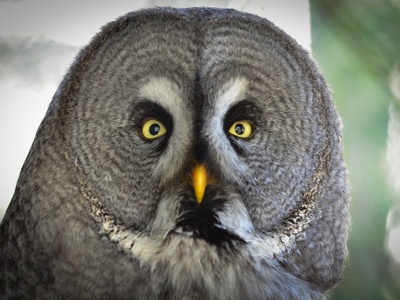
Great Gray Owl
Huge, long-legged owl with a round face and yellow eyes; appears ghostly in dim forest. Hunts over open patches and clearings in taiga; vulnerable to large-scale habitat loss.
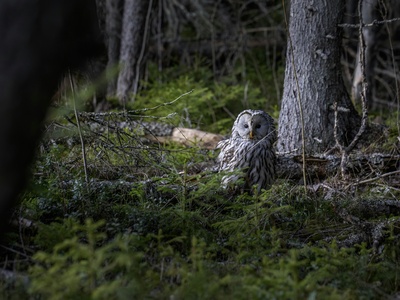
Boreal (Tengmalm’s) Owl
Small, round-headed owl with streaked plumage and large yellow eyes. Nests in tree cavities, favors mature conifers and mixed stands; mostly active at night.
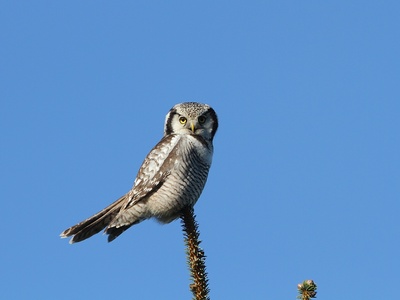
Northern Hawk-Owl
Daytime-hunting owl with long tail and hawk-like flight. Perches conspicuously on dead trees, scanning open patches of taiga for small mammals and birds.
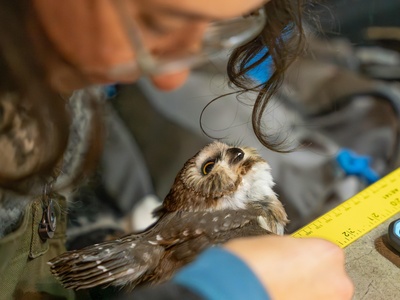
Northern Saw-whet Owl
Tiny, round owl with bold facial disk and white streaking. Secretive cavity nester found in dense boreal woods; often heard at night during breeding season.
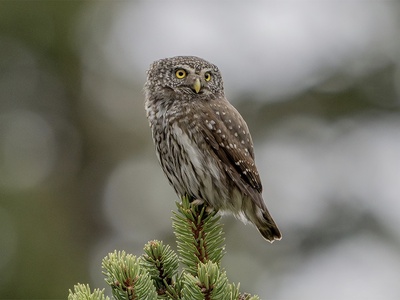
Eurasian Pygmy Owl
Small, fierce owl often hunting by day. Compact with spots, yellow eyes and a loud, repetitive call. Prefers mature conifer stands and forest edges.

Northern Goshawk
Powerful forest raptor with broad wings and long tail; gray above with barred underparts. Agile hunter of woodland birds and mammals, nests in large mature conifers.

Osprey
Large fish-eating raptor that nests on platforms and dead trees near boreal waters. Distinctive hovering dive for fish; returns to boreal lakes each spring to breed.
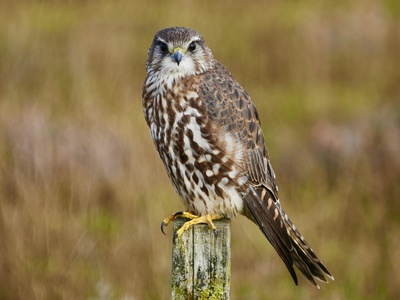
Merlin
Small, fast falcon with streaky underparts and rapid flight. Hunts small birds over openings and along forest edges in the taiga; often cryptic plumage.
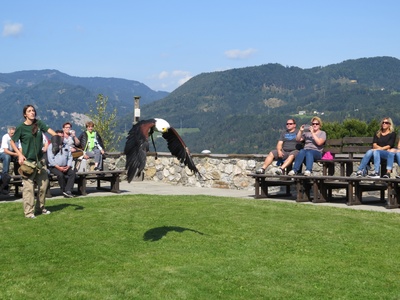
Bald Eagle
Massive, fish-eating raptor often associated with boreal lakes and rivers. Adults show white head and tail; nests in tall trees or cliffs near water.
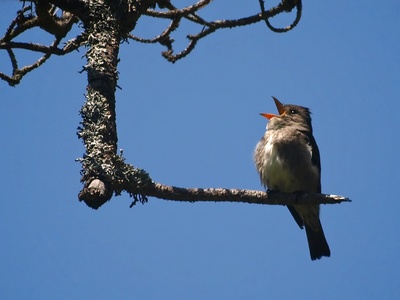
Olive-sided Flycatcher
Tall-perched flycatcher with a stocky body and pale throat patch. Waits on exposed snags to sally for flying insects in forest clearings and burned stands.

Yellow-bellied Flycatcher
Small, subtle empid with faint eye-ring and thin bill. Prefers wet, coniferous bogs and low trees; more often heard than seen.

Alder Flycatcher
Small, brownish flycatcher with sharp “che-bek” call. Nests in dense alder or willow thickets across boreal wetlands and shrubby clearings.

Gray-cheeked Thrush
Plain, olive-brown thrush with faint eye-ring and ethereal flute-like song. Prefers mossy, damp coniferous forests and regenerating burn areas for breeding.
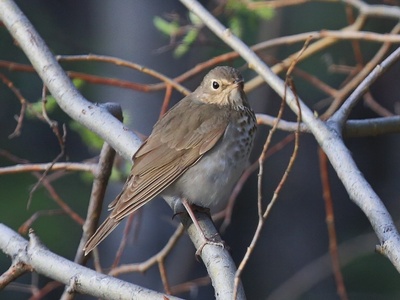
Swainson’s Thrush
Olive-brown thrush with buffy eye-ring and upward-spiraling song. Common in boreal understory and riparian corridors during summer breeding season.

Hermit Thrush
Reddish-brown back with flushed tail and clear, flute-like song. Favors dense understory in boreal woods, often perches low when singing at dawn.
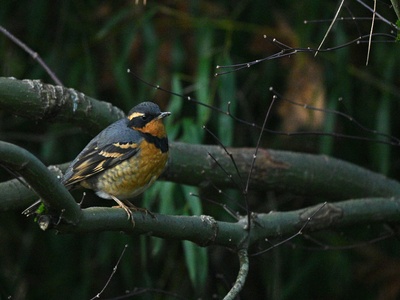
Varied Thrush
Striking orange-and-black thrush of Pacific taiga. Secretive on forest floor, often in old-growth stands and dense mossy undergrowth; melodic, low-pitched song.
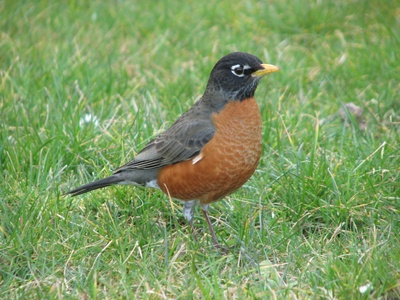
American Robin
Familiar orange-breasted thrush found in boreal openings and margins. Ground forager for insects and berries; often one of the first migrants to arrive in spring.

Redwing
Small thrush with white eye stripe and red flanks. Breeds in northern taiga and migrates to more temperate regions in winter; sings a high, thin song.

Common Raven
Large, glossy black corvid with powerful beak and deep voice. Extremely adaptable; forages across taiga, from forest interiors to coastal fringes, often near carcasses and human sites.

Gray Jay
Bold, gray corvid often called Canada Jay. Attends campsites, caches food in bark, and perches conspicuously. Vulnerable to rising temperatures affecting food storage reliability.
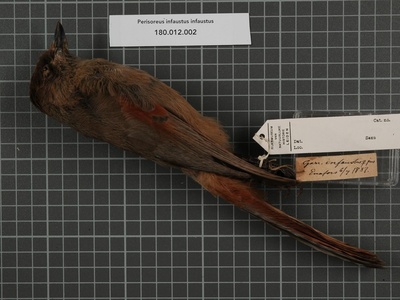
Siberian Jay
Shy, warm-toned jay that inhabits mature conifer forests. Often seen alone or in pairs, feeding on insects, berries and cached items; less trusting of humans than gray jay.

Eurasian Nutcracker
Chunky bird with strong bill and spotted plumage. Specializes on conifer seeds (nuts), caches widely, and is associated with pine-dominated boreal stands and mountain taiga.

Boreal Chickadee
Small, gray-brown chickadee with cap and subtle white cheeks. Highly territorial in winter flocks; forages in conifers for insects and seeds, common in boreal neighborhoods.
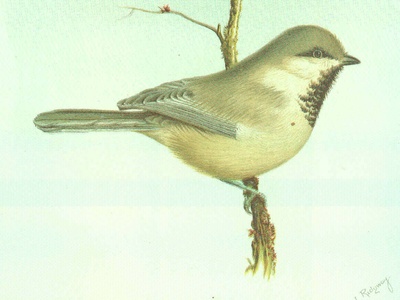
Siberian Tit
Small, compact tit with dark cap and buff underparts. Prefers old conifer stands and cached food habits; less social than southern tit species.

Willow Tit
Plain, small tit with a dark cap and pale cheeks. Excavates nesting cavities in rotten wood and favors damp boreal forests and bog margins.
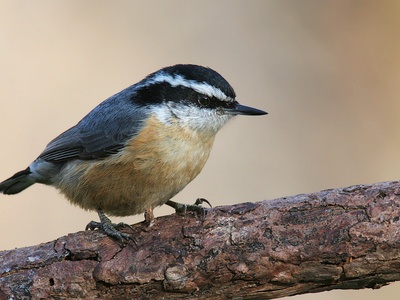
Red-breasted Nuthatch
Small, blue-gray nuthatch with rufous underparts and a black eye stripe. Walks head-first down trunks, probing bark for insects and seeds; often sings nasal calls.
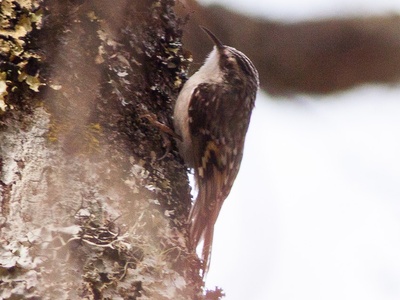
Brown Creeper
Slim, brown streaked bird creeping up trunks in spirals. Thin bill probes bark crevices for insects; superbly camouflaged and often overlooked in dense taiga.
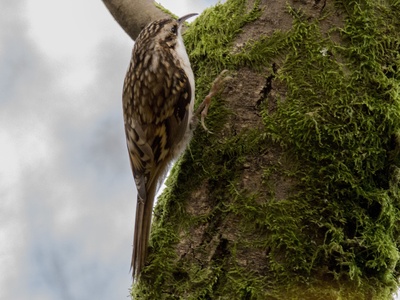
Eurasian Treecreeper
Small, brown streaked climber that spirals up trunks, using a thin, curved bill to extract insects. Quiet and well camouflaged in mature boreal forests.
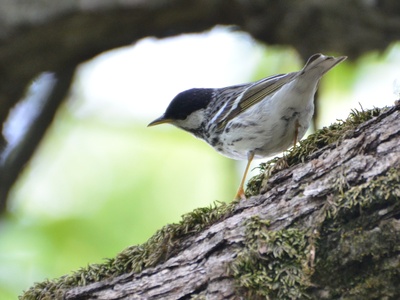
Blackpoll Warbler
Plain olive above with streaked underparts and a thin bill. Breeds in spruce-dominated taiga, undertakes remarkable long-distance migrations to South America.

Bay-breasted Warbler
Richly colored in breeding males with chestnut flanks and throat. Nests in spruce-fir taiga, feeds heavily on spruce budworm during outbreaks; migratory and secretive.

Blackburnian Warbler
Brilliant orange throat in males set against black and white plumage. Prefers canopy of mature conifer stands in taiga; often detected by high, thin song.
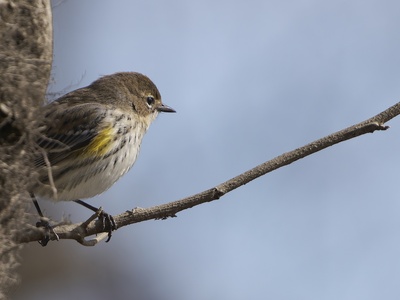
Yellow-rumped (Myrtle) Warbler
Quick, streaked warbler with yellow patches on sides and crown. Abundant in coniferous taiga where it gleans insects and berries, often persists late in season.
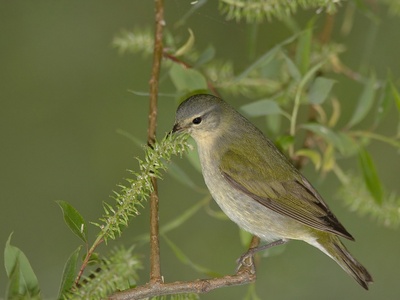
Tennessee Warbler
Plain gray-green warbler that breeds across moist boreal woodlands, often in regenerating areas. Very active, often foraging in low foliage for insects during summer.
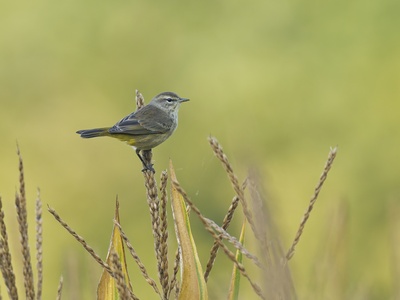
Palm Warbler
Tail-wagging warbler with a chestnut crown in spring. Favors open bogs, low scrub, and mossy clearings within the taiga for nesting and foraging.
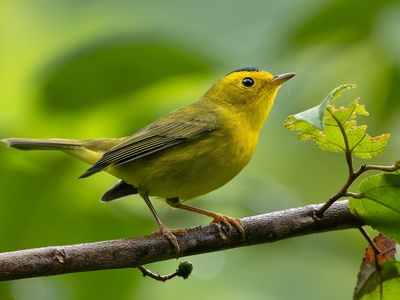
Wilson’s Warbler
Small, plain greenish warbler with a dark cap in males. Nests in dense shrubs and regenerating thickets across boreal zones; quick mover, large migratory flocks.

Ovenbird
Streaked, ground-nesting warbler with bold “teacher-teacher” song. Prefers mossy forest floor for cryptic nesting in boreal stands and mature conifers.
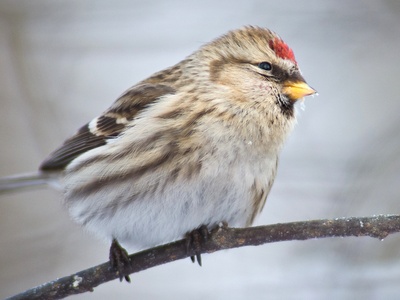
Common Redpoll
Small finch with red forehead and streaked sides. Feeds on birch and alder seeds, often in large nomadic flocks across the taiga; irruptive winters.
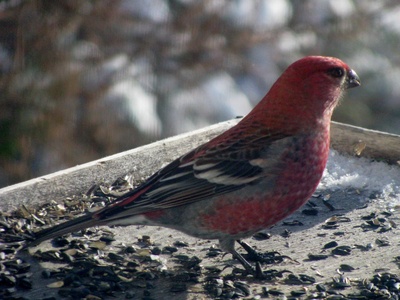
Pine Grosbeak
Large, gentle grosbeak with heavy bill; males rosy pink, females gray and yellowish. Feeds on buds and seeds of pines and mountain shrubs in taiga.

Evening Grosbeak
Large, thick-billed finch with bold yellow, black and white pattern; often feeds on seeds in flocks. Populations fluctuate with conifer seed crops.

Red Crossbill
Distinctive crossed bill for extracting conifer seeds. Plumage varies with sex and age; highly mobile in response to cone crops in the taiga.
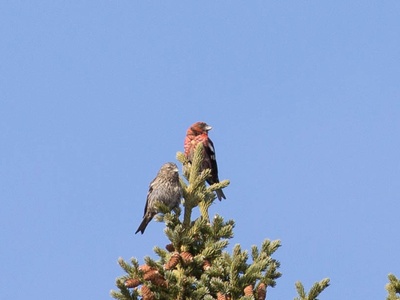
White-winged Crossbill
Smaller crossbill with bold white wing bars. Specializes on spruce and larch cones in northern taiga; appears in large numbers during irruptions.
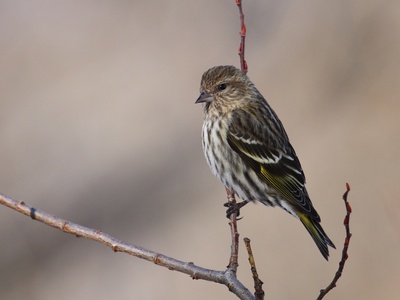
Pine Siskin
Small, streaky finch with yellow wing markings. Feeds on seeds and insects in conifers; numbers fluctuate widely with seed availability across the boreal.
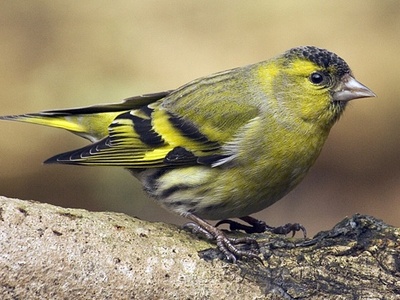
Eurasian Siskin
Small lively finch with forked tail and streaky underparts. Flocks through spruce stands and feeds on alder and spruce seeds in the taiga.
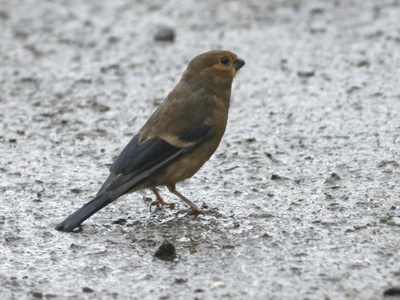
Eurasian Bullfinch
Plump finch with a thick bill; males show pinkish underparts and black cap. Prefers mixed boreal woodlands and forest edges, discreet and often found near seed sources.
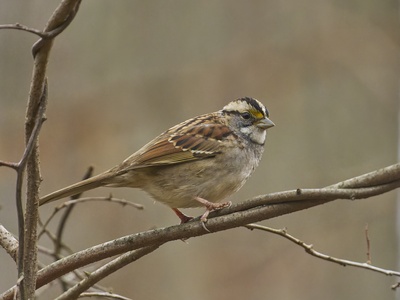
White-throated Sparrow
Bold white throat and yellow lores distinguish this sparrow. Favors boreal understory and regenerating areas for nesting, sings clear whistled song in summer.
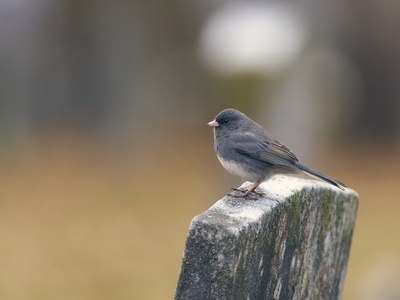
Dark-eyed Junco
Slate-gray or patterned sparrow with pink bill; hops on forest floor searching for seeds and insects. Common in boreal clearings and conifer understory.
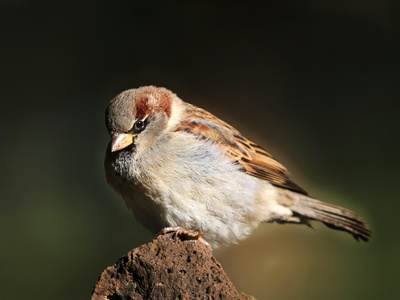
Fox Sparrow
Large, heavily streaked sparrow with warm buffy tones. Prefers dense, damp willow and alder thickets in the taiga for nesting and foraging.

Yellow-bellied Sapsucker
Medium woodpecker that drills neat rows of sap wells in living trees. Distinctive zebra-like back and red throat in males; uses boreal deciduous-conifer mixtures.

Belted Kingfisher
Blue-gray, stocky fishing bird with shaggy crest and loud rattling call. Nests in riverbank burrows near boreal waterways, often seen perched above ponds and streams.
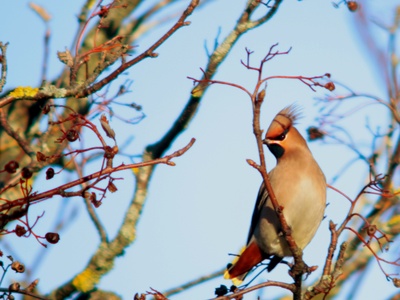
Bohemian Waxwing
Sleek, crest-topped bird with cinnamon wash and black face mask. Feeds heavily on berries and seeds, often in nomadic flocks through boreal berry crops.

Steller’s Jay
Bold, crest-headed jay with dark blue body and black head. Common in western taiga and montane conifer stands, noisy and opportunistic around campsites.
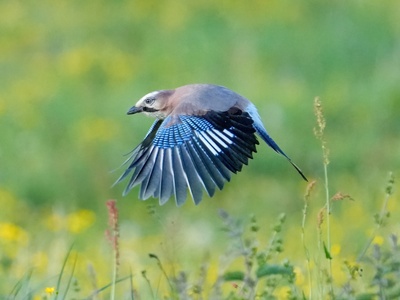
Eurasian Jay
Colorful corvid with pinkish body, black moustache and blue wing patch. Usually found in mixed woodlands and forest edges; caches acorns and nuts.

Common Goldeneye
Medium diving duck nesting in tree cavities, bright triangular white cheek patch in males. Often seen on clear boreal ponds and lakes during breeding season.
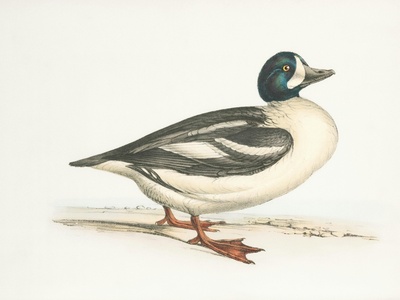
Barrow’s Goldeneye
Similar to common goldeneye but different facial pattern; nests in cavities and tree holes near boreal water bodies, sometimes inland or coastal depending on region.
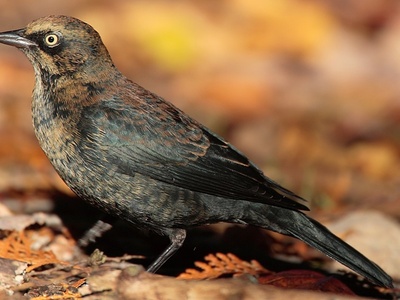
Rusty Blackbird
Dark, slender blackbird with rusty fringes in non-breeding plumage. Strongly tied to boreal muskegs and peatlands; populations have declined steeply, a conservation concern.

Golden-crowned Kinglet
Tiny, energetic kinglet with bright yellow crown stripe and high-pitched call. Forages actively in conifer canopies, often in mixed flocks across the taiga.

Ruby-crowned Kinglet
Minute, olive-green bird with bright ruby crown in males. Hunts small insects in foliage and lower branches; common during breeding season in boreal scrub and young stands.

Northern Shrike
Predatory songbird with hooked bill and masked face. Hunts from perches, impales prey on thorns or barbed wire; associated with open woodland and taiga clearings.
